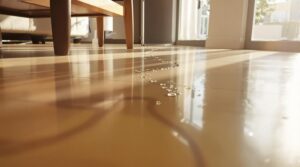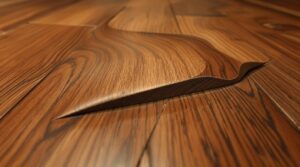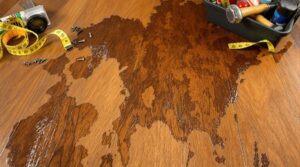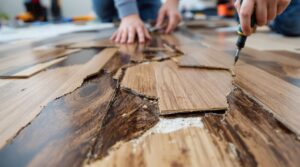Hardwood floor cupping requires immediate moisture assessment using calibrated meters to identify the source. A dehumidifier should be deployed to maintain indoor humidity between 30-50%. Documentation of board edge conditions establishes a monitoring baseline. Professional evaluation becomes necessary if cupping persists despite moisture control efforts. Severe cases may involve structural issues or unidentified moisture intrusion points. Understanding the full scope of remediation options guarantees ideal outcomes for new floor installations.
Key Takeaways
- Identify and address moisture sources immediately by checking for leaks, high humidity, or subfloor dampness using calibrated moisture meters.
- Install dehumidifiers and ensure proper ventilation to maintain indoor humidity levels between 30-50%.
- Document the extent of cupping through photos and measurements to establish a baseline for monitoring changes.
- Avoid sanding or repairs until moisture levels stabilize, as premature fixes can worsen the problem.
- Contact a professional if cupping persists after moisture control efforts or if structural issues are suspected.
Understanding Hardwood Floor Cupping
Hardwood floor cupping presents a common yet concerning issue for property owners and flooring professionals alike. This condition occurs when individual floorboards develop a concave shape, with edges rising higher than the center, creating a distinctive wave-like pattern across the surface.
At its core, cupping stems from moisture management challenges, specifically when boards experience uneven moisture exposure between their top and bottom surfaces. The bottom portion of the board, absorbing more moisture, expands disproportionately compared to the top, resulting in the characteristic curved shape. Fixing cupped floors often requires professional moisture testing to determine the extent of the problem and develop an effective solution. Addressing cupped wood floor concerns is essential to maintaining both the aesthetics and structural integrity of your flooring. Failure to resolve these issues can lead to further damage, such as splintering or buckling, which may necessitate expensive repairs or replacement. Therefore, it is crucial to identify the source of moisture imbalance and implement appropriate corrective measures to restore the floor’s original condition.
During flooring maintenance inspections, this condition becomes particularly visible when light reflects off the surface, revealing telltale shadows where board edges have lifted. Understanding these fundamental mechanics helps identify early warning signs and implement appropriate preventive measures before significant damage occurs.
Common Signs and Causes of Cupping
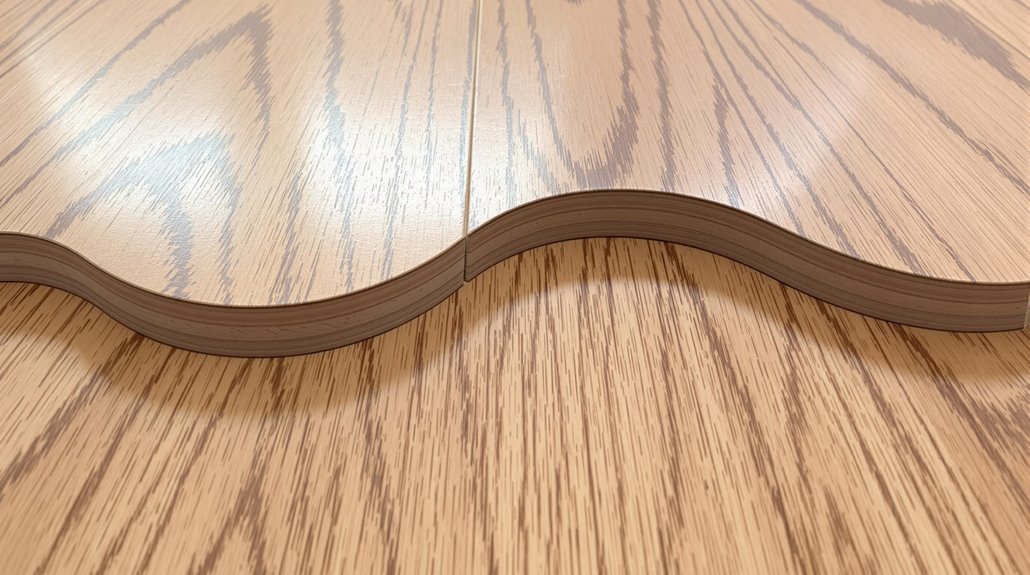
Recognizing the early warning signs of floor cupping enables property owners and professionals to implement corrective measures before extensive damage occurs.
Primary cupping symptoms include raised edges on floorboards, creating a concave shape, along with wavy appearances and potential gaps between boards. In severe cases, discoloration may appear due to moisture exposure. Cupping can cause cracking and splintering if the wood cannot return to its original shape.
Multiple moisture sources can trigger cupping in new hardwood floors. Environmental factors like seasonal humidity changes and high ambient moisture levels contribute notably.
Installation-related issues, including insufficient wood acclimation and improper subfloor preparation, also play vital roles. Common moisture intrusion points include subfloor dampness from inadequate ventilation, leaky plumbing, and improper cleaning methods.
Understanding these causes is essential for developing effective prevention strategies and maintaining the structural integrity of hardwood flooring.
Immediate Actions to Take
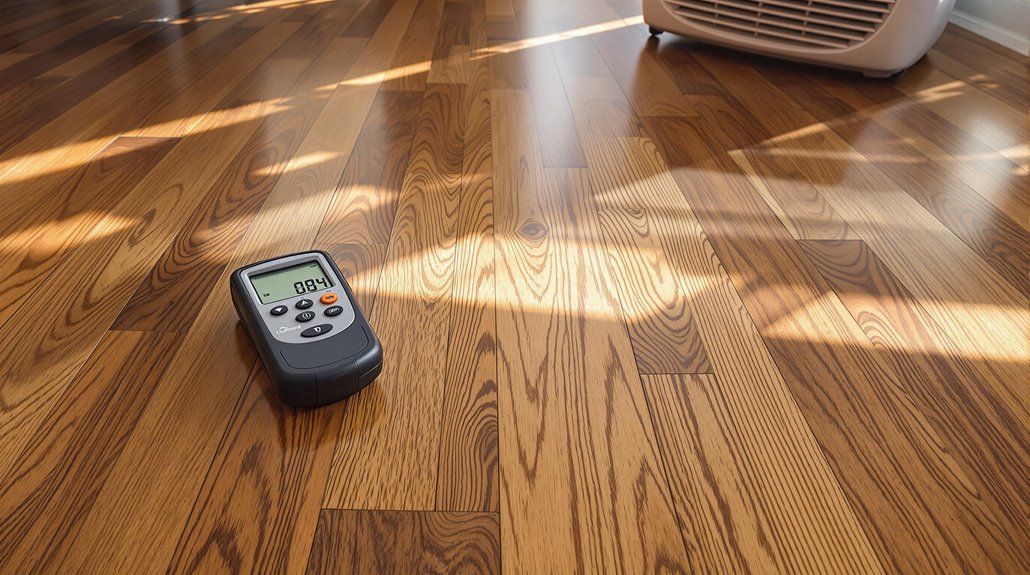
Swift action is essential when cupping appears in new hardwood floors, requiring a systematic approach to assessment and stabilization. Begin with thorough moisture detection across multiple areas using calibrated meters to identify problem zones and document findings. Implement immediate humidity control measures through dehumidification and proper ventilation to stabilize the environment. Since cupping creates a concave shape in wood planks, careful inspection of board edges will help determine severity levels.
| Action Phase | Primary Tasks | Expected Outcomes |
|---|---|---|
| Assessment | Moisture readings | Problem identification |
| Documentation | Record findings | Baseline establishment |
| Stabilization | Control humidity | Environment balance |
| Monitoring | Track changes | Progress evaluation |
| Prevention | Address sources | Long-term protection |
Professional consultation may be necessary if initial interventions don't yield improvement. Focus on gradual drying while maintaining consistent environmental conditions to prevent additional stress on the wood fibers. Implementation of vapor barriers or subfloor treatments may be required for lasting moisture control.
Long-Term Solutions and Prevention
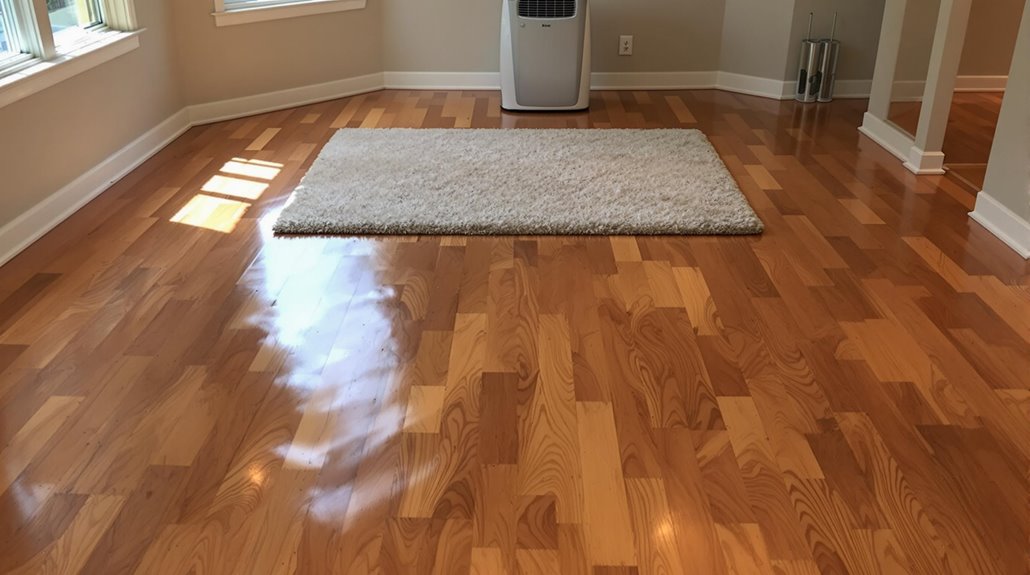
Lasting protection against hardwood floor cupping requires a thorough preventive strategy encompassing moisture control, proper installation protocols, and ongoing maintenance measures.
Essential components include maintaining indoor humidity levels between 30% and 50% through dehumidifiers or humidifiers, implementing proper subfloor preparation, and installing effective moisture barriers.
Successful flooring maintenance involves regular inspections for moisture intrusion, prompt cleanup of spills, and the strategic use of area rugs in high-traffic zones.
Professional intervention may be necessary for severe cases, potentially including sanding and refinishing once moisture issues are resolved.
To guarantee long-term floor stability, homeowners should seal subfloors or install vapor barriers, maintain consistent ventilation, and use appropriate cleaning products designed specifically for hardwood surfaces.
Regular monitoring of environmental conditions helps prevent future cupping issues.
When to Call a Professional

When hardwood floor cupping exceeds the scope of DIY remediation, professional intervention becomes vital for proper restoration. Severe or recurring cupping, despite moisture control efforts, signals the need for professional evaluation. This is particularly important when structural issues are suspected or when the underlying cause remains unidentified.
Professional contractors possess specialized tools for accurate moisture measurement and diagnostic capabilities that identify hidden problems within the subfloor. Their expertise guarantees proper assessment and implementation of effective repair techniques, preventing permanent damage that often results from inadequate DIY attempts.
Additionally, professionals can address complex issues like foundation settling and provide extensive solutions that include preventive measures. Their specialized knowledge and high-quality equipment ensure long-term preservation of the hardwood flooring investment.
The Benefits Of Consulting A Public Adjuster
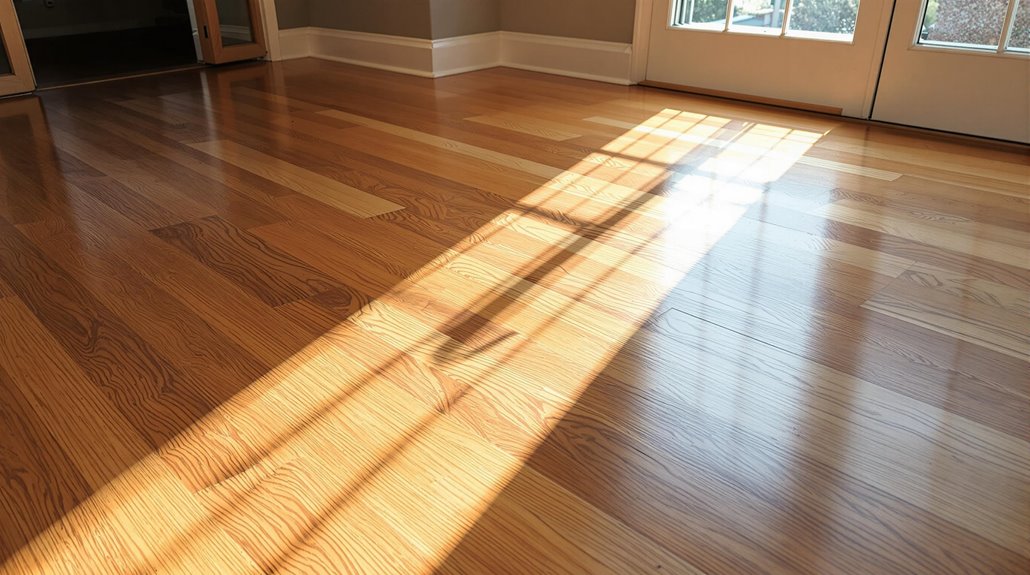
When encountering cupped hardwood floors, consulting a public adjuster provides access to specialized expertise in insurance claims and objective damage assessment protocols.
A licensed public adjuster streamlines the claims process by accurately documenting damages, interpreting policy coverage, and managing all necessary paperwork.
Their professional negotiation skills and industry knowledge typically result in higher claim settlements, ensuring proper compensation for both visible damage and potential long-term flooring issues.
Working with public adjusters has shown increased settlement amounts of up to 500% for non-catastrophic property damage claims compared to handling claims independently.
Expertise In Insurance Claims
Insurance complexities surrounding water-damaged hardwood floors often necessitate professional expertise to navigate claims successfully. Public adjusters bring extensive insurance policy knowledge that enables them to interpret coverage details and guarantee all entitled benefits are properly claimed.
Their specialized understanding of policy language and exclusions proves invaluable when documenting hardwood floor damage. Through skilled claims process navigation, these licensed professionals meticulously prepare documentation, gather necessary evidence, and present thorough claims to insurance carriers.
They understand insurance company tactics and negotiate effectively to maximize settlements for cupped flooring repairs. Their expertise extends to identifying all related damages, making sure nothing is overlooked during the claims process.
This professional representation allows property owners to focus on recovery while maintaining confidence that their claim is being handled efficiently.
With settlement rates higher when public adjusters manage claims, property owners often see improved compensation for their damaged hardwood floors.
Objective Damage Assessment
Professional damage assessment conducted by public adjusters provides property owners with essential unbiased evaluations of their hardwood floor damage. Through extensive damage evaluation procedures, adjusters document all visible and hidden issues affecting the flooring system, guaranteeing accurate representation for insurance claims.
| Assessment Component | Benefit to Claim |
|---|---|
| Moisture Testing | Identifies water damage extent |
| Photo Documentation | Provides visual evidence |
| Structural Analysis | Reveals subfloor impacts |
Public adjusters conduct thorough inspections that identify contributing factors such as moisture intrusion, improper installation, or environmental conditions. Their detailed documentation strengthens the policyholder's position during claim negotiations, helping to secure appropriate compensation for repairs or replacement. This systematic approach guarantees all damage aspects are properly evaluated and documented according to insurance industry standards. Since public adjusters focus on validating claims rather than representing insurance companies, they provide powerful advocacy for homeowners seeking fair settlements.
Streamlined Claim Process
Engaging a public adjuster greatly streamlines the complex process of filing and settling hardwood floor damage claims.
These licensed professionals possess extensive knowledge of insurance policies and procedures, enabling accurate policy interpretation and efficient claim processing.
Public adjusters handle all aspects of claim documentation, from detailed damage assessments to repair estimates.
They meticulously gather evidence, prepare necessary paperwork, and manage negotiations with insurance carriers, considerably enhancing claim efficiency.
Their expertise in understanding insurance company tactics and regulatory requirements proves invaluable during settlement discussions.
Operating on a contingency fee basis, public adjusters typically charge 5-20% of the final settlement amount while working to maximize your claim payout.
Higher Claim Payouts & Settlements
Beyond streamlined processing, one of the most compelling reasons to retain a public adjuster is the potential for markedly higher claim settlements.
Public adjusters leverage their expertise in policy interpretation and damage assessment to identify all compensable losses related to hardwood floor cupping.
Through effective negotiation with insurance carriers, public adjusters typically secure higher settlements by ensuring that all aspects of the damage are properly documented and valuated.
Their understanding of policy language and coverage provisions enables them to challenge inadequate settlement offers and present compelling evidence for maximum compensation.
Working on a contingency basis, public adjusters are inherently motivated to maximize claim values while maintaining compliance with insurance regulations.
Their professional expertise in damage evaluation and policy interpretation often results in settlements that markedly exceed initial insurance company offers.
While charging up to 10% commission rates, public adjusters consistently help policyholders recover significantly more than they would receive from insurance company adjusters working to minimize costs.
About The Public Claims Adjusters Network (PCAN)
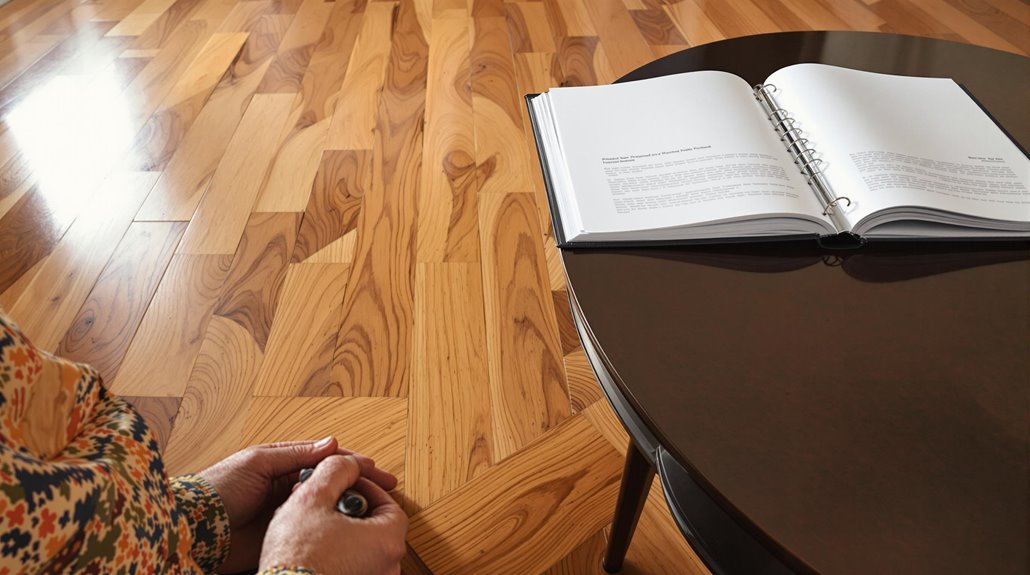
The Public Claims Adjusters Network (PCAN) represents a collaborative alliance of licensed public insurance adjusters who work collectively to serve policyholders across multiple jurisdictions.
This network of professional claims adjusters leverages shared expertise and resources to maximize insurance claim settlements for property owners experiencing hardwood floor damage and other losses.
PCAN members specialize in extensive claims management, offering policyholders expert damage assessment, thorough documentation, and strategic negotiation services.
The network's approach combines individual adjuster expertise with collective industry knowledge to navigate complex insurance processes effectively.
Through standardized procedures and proven methodologies, PCAN adjusters streamline the claims process while maintaining rigorous advocacy standards for their clients.
This systematic approach helps guarantee ideal claim outcomes while reducing stress and administrative burden for affected property owners.
Frequently Asked Questions
How Long Does It Typically Take for Cupped Hardwood Floors to Flatten Naturally?
Recovery timeframes for cupped hardwood floors vary from weeks to months, depending on cupping causes and flooring maintenance practices. Minor cases resolve within 8 weeks; severe cases require 6-12 months.
Can Using Fans Speed up the Drying Process for Cupped Floors?
Fans offer limited effectiveness in accelerating hardwood floor drying processes. While they assist with air circulation, ideal drying techniques require combining fans with dehumidifiers and environmental controls for meaningful results.
Will Insurance Cover Hardwood Floor Cupping From Natural Humidity Changes?
Like a denied credit card, insurance claims for hardwood floor cupping caused by natural humidity damage typically face rejection, as standard policies only cover sudden, accidental water events, not gradual environmental changes.
What Humidity Level Should I Maintain to Prevent Floor Cupping?
Proper humidity control requires maintaining indoor levels between 35-55%, with 45% being the ideal range. Consistent monitoring and adjustment through humidifiers or dehumidifiers helps prevent wood floor cupping issues.
Does the Direction of Wood Grain Installation Affect Likelihood of Cupping?
When push comes to shove, wood grain direction greatly impacts cupping susceptibility. Installation techniques should align boards perpendicular to joists, with quartersawn boards offering superior stability against moisture-related deformation.
References
- https://basementmasterswaterproofing.com/blog/what-causes-my-cupping-hardwood-floors-basement-masters/
- https://blog.cityfloorsupply.com/how-to-fix-hardwood-floor-problems-cupping-crowning-chatter/
- https://www.springcarpets.com/blog/articles/understanding-hardwood-floor-cupping-causes-effects-and-solutions
- https://www.fromtheforest.com/blogs/fromtheforest/floor-cupping-what-you-need-to-know
- https://www.firstatlantaflooring.com/news/hardwood-floor-cupping-what-is-it-and-how-can-you-fix-it/
- https://www.wagnermeters.com/moisture-meters/wood-info/can-wood-floor-cupping-be-fixed/
- https://artisanwoodfloorsllc.com/hardwood-flooring-blog/what-is-cupping-in-hardwood-floors-causes-prevention-and-solutions/
- https://www.wagnermeters.com/moisture-meters/wood-info/spotting-trouble-hardwood-floors/
- https://www.diverseflooring.ca/blog/articles/how-to-fix-hardwood-floor-cupping-tips-and-solutions
- https://www.bona.com/en-us/professional/articles/helping-with-wood-floor-cupping/
